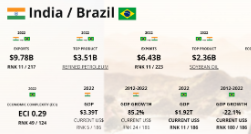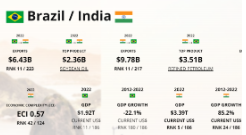India and Brazil, two influential emerging economies, are taking significant steps to strengthen their trade resilience amidst global challenges. The global trade landscape is experiencing a period of immense turbulence. The LAC region, including Brazil, represents India’s largest trade potential, with a 27% share of the total trade potential of the region. India’s strategy for long-term engagement with LAC countries involves analyzing trade policies, understanding the tariff structure, and pursuing dynamic trade strategies to deal with regional trade agreements (RTAs) at different levels. Two of the developing economies in the world, Brazil and India, are excellent instances of this strategic cooperation.
The period between 2004 and 2014 saw an enormous increase in commercial trade between India and Brazil. In these 10 years, exportations from Brazil to India increased by 735% and importations from India to Brazil grew by 1194%, according to the data available from the Ministry of Economy of Brazil. Historically for the past 10-15 years, both countries have also been involved in several multilateral groups and forums that include the BRICS, IBSA, G4, G20, and BASIC, supporting each other’s interests.

A snapshot of the Exports from Brazil to India, and Imports from India to Brazil between 2004-2014.
Current India-Brazil Trade Relations:
Bilateral trade has seen significant growth, back in 2022, it reached $15.2 billion, a substantial increase from $7.9 billion in 2015 [Embassy of India, Brasilia]. As per the OEC world,
India exported $9.78B to Brazil. The main products that India exported to Brazil are Refined Petroleum, Pesticides, and Nitrogen Heterocyclic Compounds. During the last 27 years, the exports of India to Brazil have increased at an annualized rate of 16.8%, from $147M in 1995 to $9.78B in 2022.

A snapshot of India’s exports to Brazil, based on the OEC World data.
Whereas Brazil exported $6.43B to India. The main products that Brazil exported to India are Soybean Oil, Crude Petroleum, and Gold. During the last 27 years, the exports of Brazil to India have increased at an annualized rate of 11.2%, from $366M in 1995 to $6.43B in 2022.

A snapshot of Brazil’s exports to India, based on the OEC World data.
Commerce Secretary Sunil Barthwal on his last visit said that India and Brazil are looking at an “aspirational” target of increasing the two-way trade by over three-fold to USD 50 billion by 2030.
Based on an article by the Economic Times, the current bilateral stands at USD 15.2 billion.
The India-Brazil trade growth has been resilient due to several factors, some of which include
- Complementary Economies: India’s strength in pharmaceuticals, information technology, and textiles complements Brazil’s expertise in agriculture, energy, and aviation. This complementarity fosters mutually beneficial trade exchanges.
- Focus on Diversification: Both nations are making concerted efforts to broaden the scope of their trade, going beyond conventional goods like soybeans and iron ore. This lessens reliance on any one product category and lowers the danger of price changes.
- Government Initiatives: Both the Indian and Brazilian governments have implemented policies to boost bilateral trade. These include tariff reductions, streamlined customs procedures, and the establishment of joint working groups to address trade barriers.
Strategic Partnerships
Trade Resilience goes beyond trading products and services. It is mostly inclined towards building an ecosystem. India and Brazil are taking concrete steps in this direction through several initiatives. Strengthening Institutional Linkages has been one of the crucial ones.
Regular meetings between India’s and Brazil’s joint commissions provide a platform for discussing trade issues, identifying bottlenecks, and exploring new avenues for cooperation. Business Councils have been formed to promote seamless cooperation and interaction between various businesses. BRICS AND the Brazil-India Chamber of Commerce are two of the most powerful groups that have been working to promote trade and cultural relations between India and Brazil.
India and Brazil have emerged as significant players in the nearshore outsourcing industry, particularly in IT and BPO industries. While India has long been established as a leader in offshore outsourcing, Brazil has recently gained traction as a nearshore outsourcing destination, offering its own set of advantages to companies seeking to outsource their operations.
Cooperation in Key Sectors
There have been a lot of sectors that have seen a large number of investments between India and Brazil. Some of them include:
- Agriculture: Cooperation in value-added products, technology transfer, and agricultural research can guarantee food security and open up new markets.
- Renewable Energy: Both countries are committed to clean energy transition. Cooperation in biofuels, solar, and wind power can lead to joint ventures and knowledge exchange.
- Information Technology: Working together to develop digital infrastructure, the knowledge economy, and IT services can benefit both countries.
Building a Resilient Future
India and Brazil are actively pursuing strategies to foster trade resilience and ensure sustainable growth in the face of economic turbulence. Trade resilience is not a one-time achievement but an ongoing process, which also serves as a model for the economies to prepare for the shocks and complexities of the global market. India-Brazil relationships are fortifying their positions in the international market and improving their capacity to resist external shocks by expanding their trade partners, making infrastructural investments, encouraging innovation, and implementing sustainable practices.
India and Brazil are also collaborating in several international forums, including BRICS, IBSA, G4, G20, BASIC, and the UN, to hold the world in flux and explore opportunities for increased cooperation. Both countries have a long and robust tradition of engaging in forums where they have often developed strong and enduring relationships and have shared perceptions of multipolarity providing a unique opportunity to further strengthen their strategic partnership.







